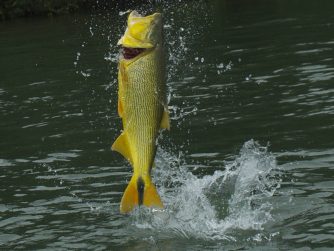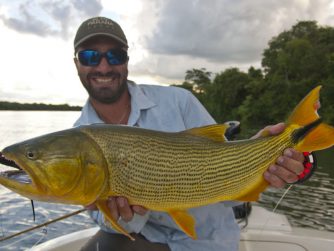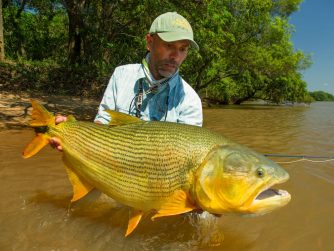Fly Fishing for Dorado
Argentina has a long history of exceptional freshwater dorado fishing. And from the massive Rio de la Plata system to the unpressured wilderness expanses of the Ibera Wetlands, Nervous Waters has been pioneering these diverse fisheries since the beginning.
The characiformes order, found in Central and South America, as well as Africa, consists of more than 2,000 individual fish species. Most are small—less than an inch long. But some reach much larger sizes, including golden dorado and the goliath tigerfish. Probably the most well known species within characiformes is the piranha. At least among the non-angling set.
In exceptional cases, dorado (Salminus maxillosus or brasiliensis) can weigh up to—or more than—30 kg. Generally speaking, however, a 4 to 5 kg dorado is considered a great fish on the fly. Golden dorado should not be confused with saltwater dorado, also called mahi-mahi and dolphin. The two species are unrelated. Golden dorado have also been grouped with salmonids over the years due to the spread of misinformation. This too is simply untrue.
Small dorado populations are found in select parts of the Amazon Basin, but the sprawling Rio de la Plata shines as a massive, multifaceted stronghold for the species. Flowing through parts of Argentina, Brazil, Paraguay, Bolivia and Uruguay, the basin is the second largest drainage system in South America, and one of the biggest in the world. Its diverse ecosystem envelops freestone rivers in the mountains, as well as marshes and lagoons in the lowlands—a system that goes from freshwater to freshwater, as opposed to the sea.
The Rio de la Plata was once called “The Sweet Sea”—a reference to its oceanic size. And today, dorado rule this diverse environment; an apex predator with a wide range of behaviors and moods influenced by seasons and habitat. Dorado can be complex, and deciphering the challenges is what keeps anglers coming back. That, and of course, the dorado’s beauty, ferocity and acrobatic tendencies. Combined, these prized attributes make freshwater dorado one of most distinguished gamefish you’ll find anywhere.
THE FISHING
- Dorado are one of the most exiting species anglers can catch on a fly.
- One of the best sections of the Paraná River to catch pira pitá and pacú on dry flies.
- Good sight-fishing opportunities for all three species.
- Tackle: 7- to 9-weight outfits for dorado and pacú; 5- to 6-weight outfits for pira pitá. All with tropical floating fly lines.
- Flies: 4- to 6-inch streamers tied on 2/0 to 4/0 hooks, include a few mice imitations; bulky floating attractors tied in 1/0 hooks and some weighted deer hair fruit imitations tied on 1/0 for pira pitá and 2/0 for pacú.
- Fishing schedule: two fishing sessions a day, coming back to the lodge for lunch and siesta. Fishing times can vary depending on season and climate. The best guides and equipment.
- This is a strictly catch-and-release program.




